Table of Contents
When it comes to software purchasing channels, you have a few choices. You could buy directly from the supplier, or buy it through a reseller (e.g., CDW or SoftwareONE) or marketplace (e.g., AWS Marketplace or Google Cloud Marketplace).
Today, our data shows that 75% of SaaS is purchased directly from suppliers rather than resellers or Cloud Marketplaces, on average. While direct still makes up the majority of purchases, this is a 86.8% decrease from 2023. But, is direct always best? The short answer is no.
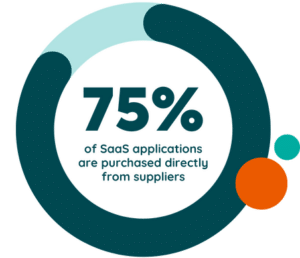 The emergence and growth of Cloud marketplaces is beginning to change the landscape. On top of that software resellers are also starting to appear in marketplaces these days.
The emergence and growth of Cloud marketplaces is beginning to change the landscape. On top of that software resellers are also starting to appear in marketplaces these days.
Due to the substantial benefits, like discount programs and consolidated billing, we expect more and more organizations to purchase SaaS through resellers and marketplaces. In fact, research from Tackle’s 2024 State of Cloud Marketplaces Report supports this shift in how companies may approach software purchasing strategies. According to the report, Tackle projects marketplace spending to reach $100B between 2026 and 2027..
Read on to understand the advantages and drawbacks of purchasing through these channels, and how to analyze the best channels and spending strategies for your business.
4 Need-to-Know SaaS Stats for Procurement Leaders
Learn MorePros and Cons of Different Software Purchasing Channels
Your company has multiple channels to consider: buying directly from suppliers, through resellers, or via marketplaces. Each route offers unique advantages and potential drawbacks, making the choice dependent on your specific needs and circumstances.
Direct from Supplier
Pros
- Purchasing directly from the supplier eliminates intermediaries, potentially reducing costs and simplifying communication.
- Establishing a direct relationship with the supplier can be beneficial, especially for new technologies where building a strong partnership is crucial for support and innovation.
Cons
- Some vendors, like Microsoft, may not have a direct selling team, necessitating alternative routes.
- Direct purchases can sometimes be more challenging due to inconsistent contacts and a lack of familiarity with the supplier’s operations, resulting in a much more transactional relationship versus a strategic one.
Software Reseller
Pros
- Resellers often negotiate massive spend agreements, offering deeper discounts than direct purchases might provide.
- Resellers offer automated reporting, consolidated billing, and streamlined procurement processes, allowing businesses to onboard and manage multiple applications through a single vendor.
- Resellers often have deep relationships with software providers and can provide governance around software purchasing and distribution, ensuring better management of licenses and needs.
- Resellers can monitor licenses, ensuring you only purchase what you need and helping manage and optimize your software use.
- There’s no need to onboard new vendors, as you are purchasing through an approved entity.
Cons
- Resellers take a small cut, which might slightly increase the overall cost of the software.
- As a buyer, you may miss the direct relationship with the vendor to get benefits such as roadmap prioritization, executive relationships, or advisory board participation.
Cloud Marketplace
Pros
- Marketplaces combine reseller benefits, such as consolidated billing and discount programs, with the ability to maximize spending commitments with cloud providers like AWS, Google Cloud, and Microsoft Azure.
- Consolidated billing helps simplify financial management and increase transparency in software spending.
- Marketplaces offer a centralized platform to manage purchases, making it easier to track and optimize software spending across different providers.
- There’s no need to onboard new vendors, as you are purchasing through an approved entity.
Cons
- There are few downsides, but one potential issue could be the dependency on the marketplace’s terms and conditions, which might not be as flexible as direct negotiations.
By evaluating these pros and cons, your organization can make informed decisions on which purchasing channel best suits your needs, ensuring efficient SaaS spend management.
Guide to Managing SaaS Costs
Learn MoreBenefits of Conducting a Software Spend and Purchasing Analysis
Conducting a spend and purchasing analysis answers the critical question, “Are we buying the way we want to buy?” By evaluating and optimizing your purchasing processes, your organization can unlock several key benefits:
#1: Streamline Purchasing Efficiency
Often, organizations find they are not following their own procurement policies, leading to inconsistent purchasing practices. A thorough analysis can identify these areas in your current purchasing methods. Streamlining your procurement process ensures that purchases are made quickly and efficiently, reducing administrative overhead and speeding up timelines.
An analysis also can help align actual buying behavior with preferred procurement strategies. In one case, aggregated data from the Google Cloud Platform provided visibility into suppliers and application owners. The company discovered IBM purchases were being made through Google, raising questions about purchasing efficiency and strategy.
#2: Make the Process Smoother
Conducting an analysis can reveal unknown or shadow IT spending. While you probably know there’s some shadow IT in your stack, our data shows it accounts for more than one-third of your applications.
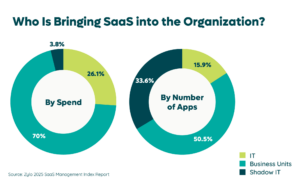 Shadow IT often occurs when employees can’t access the software they need through official channels, leading to higher costs and reduced oversight.
Shadow IT often occurs when employees can’t access the software they need through official channels, leading to higher costs and reduced oversight.
Simplifying the purchasing process can reduce the complexity involved in buying software and reduce the occurrence of shadow IT. By minimizing the steps required for approval, reducing paperwork, and centralizing procurement through preferred channels, it’s easier for employees to get the necessary tools without going rogue.
#3: Reduce Costs
By analyzing spend, your organization can identify areas where costs can be cut, purchasing inefficiencies, and instances where employees are expensing software purchases. Our data shows that 1% of spending comes from expensed software. This is from organizations that have put governance in place to reduce expense spending. That may not sound like a lot, but with the average organization spending $49M annually, it adds up quickly. Especially if you don’t have a program in place
Answering these questions can help you identify opportunities to reduce costs:
- Could we get a better price by purchasing through a different channel?
- How well are our licenses being used?
- What applications are being expensed, and how many are duplicates?
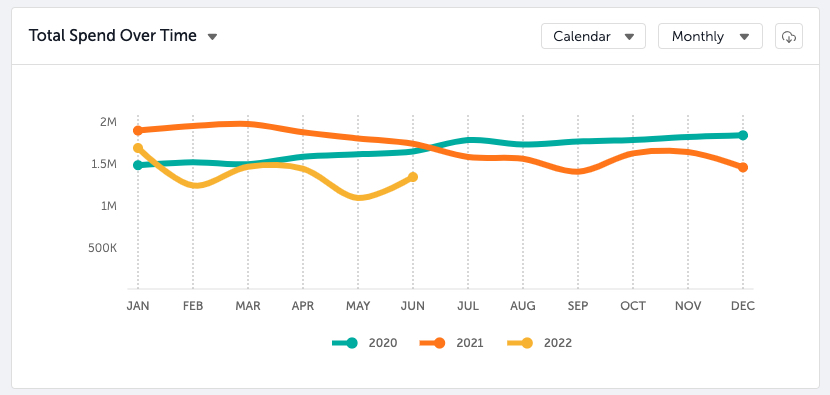
By conducting a comprehensive spend and purchasing analysis, organizations can ensure they are buying software in the most efficient, cost-effective manner, aligning with their strategic goals, and leveraging their purchasing power fully.
How to Evaluate the Best Software Purchasing Channel
Effective SaaS spend management begins with a comprehensive evaluation of your software purchasing sources. This involves analyzing various factors and centralizing visibility across all applications to ensure accurate and informed decision-making. Here’s how you can evaluate the best software purchasing channels:
Start with the Right Data
To conduct a thorough evaluation, you need centralized visibility across all applications. SaaS inventory management is the mechanism by which you get visibility and centralize key data. For your analysis, you’ll want to examine data from multiple aspects of your software procurement processes:
Payment Source
How was the application purchased: Accounts Payable (AP) or expense?
Centralizing software purchases through Accounts Payable can provide greater control and visibility over expenditures. This method ensures that all software purchases are tracked and managed through a formalized process, reducing the risk of shadow IT and unauthorized spending.
When employees purchase software and expense it, it can lead to fragmented data and reduced oversight. Analyzing expense reports can help identify instances of decentralized purchasing and bring these expenditures into a managed procurement process.
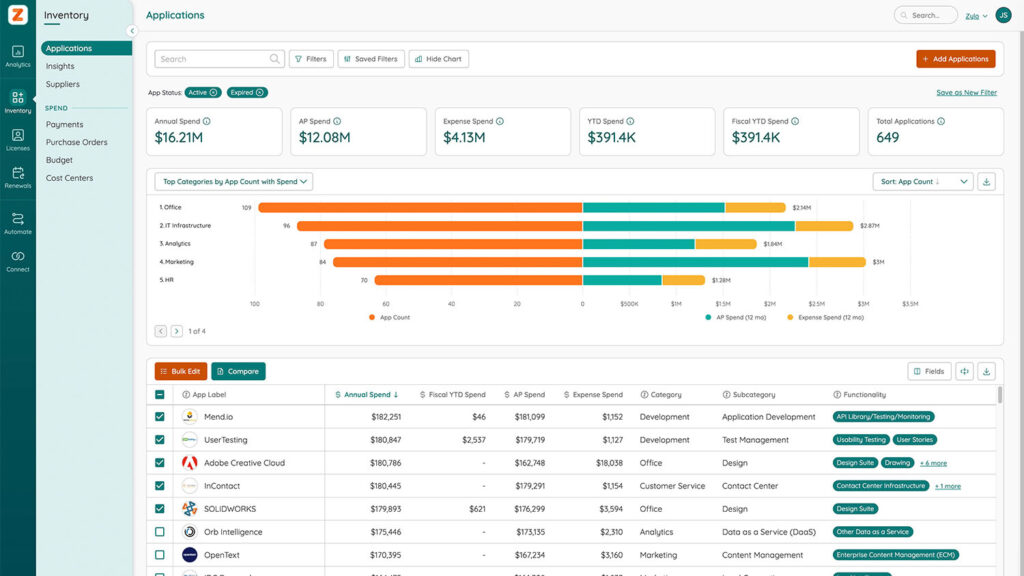
Cost Center
Which cost center is using the application?
By assigning software purchases to specific cost centers, organizations can better understand how different departments and teams utilize software budgets. This allows for more accurate budgeting, accountability, and identifying areas where costs can be optimized. Evaluating spend by cost center helps identify which departments are driving the most software spending and whether that aligns with the organization’s overall strategic goals.
Purchasing Channel
What purchasing channel was used?
Buying software directly from suppliers can provide a direct relationship with the vendor but might lack the consolidated benefits that other channels offer.
Purchasing through resellers can provide discounts, streamlined procurement processes, and enhanced vendor relationships. Resellers often offer bundled services, automated reporting, and consolidated billing, making procurement more efficient.
Cloud marketplaces like AWS, Google Cloud, and Microsoft Azure offer the best of both worlds, combining the benefits of resellers with centralized billing and potential cost savings through cloud spend commitments.
By compiling these data points, you will gain a clear picture of your software purchasing landscape. Next, you’ll use that data to conduct an analysis and determine the best course of action.
Best Practices to Evaluate Software Purchasing Channels
Collect information on all software applications and associated spending, including the data points we just covered. Then, create a report that breaks down spending across IT and non-IT cost centers, and identify the purchasing source and channel for each application. This will help you understand departmental expenses and analyze purchasing channels for patterns, inefficiencies, and savings opportunities.
Engage Application Owners
Share the analyzed data with application owners and stakeholders. Summarize spending patterns and inefficiencies, then gather feedback on possible actions to optimize software purchasing and usage.
As a Procurement team, use this information to develop a strategy, whether that’s to streamline your purchasing processes, switch purchasing channels, or negotiate better terms. Implement the strategy, keep stakeholders informed, and adjust as needed.
Work Backward from the Renewal Date
Renewal is where the rubber meets the road – the one time of year you can change your SaaS contracts. If you choose to change your software purchasing source, be sure to make changes before renewal. Be sure to regularly evaluate channels – aligned to the renewal cycle – to prevent rogue spending and ensure adherence to the strategy.
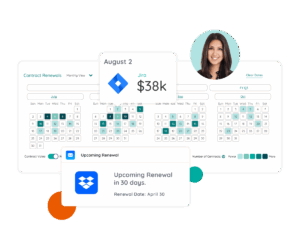
Utilize a SaaS Management Platform
Use a SaaS Management Platform for ongoing visibility into your SaaS applications and spending. This is critical to ensuring accurate data collection so you can identify the best purchasing options and maximize value. With this visibility, you’ll also be able to continuously monitor and adjust strategies for optimal SaaS spend management.
Improve Your Software Purchasing with Zylo
Following these steps will help you improve software purchasing processes, ensure efficient resource use, and maximize value. It all starts with knowing what’s in your SaaS inventory. Learn how Zylo’s Discovery & Inventory Management solution gives you full visibility and control over your SaaS environment for a comprehensive solution.
For more data like those used in this blog post, check out our list of 111 unmissable SaaS stats, or download our SaaS Management Index.

